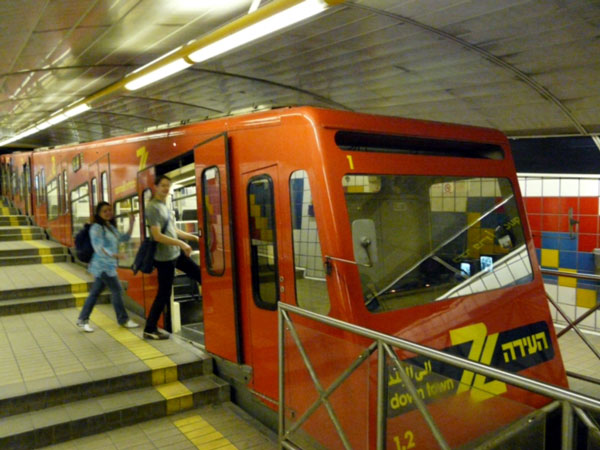When an Israeli city is brought up in a conversation, ropeway technology probably isn’t often the first topic that comes to mind. However, for the city of Haifa in northern Israel, readers might be surprised that Cable Propelled Transit (CPT) has actually been an integral part of the city’s transport network for nearly sixty years. Geographically, since the city was built beside the Mediterranean coast along the slopes of Mount Carmel, ropeways have provided a logical means of overcoming Haifa’s topographical constraints. Today, two ropeways have been constructed in the city — the Haifa Cable Car (pulsed gondola) and the Carmelit.
The Carmelit is a short 1.75km, 6-station underground funicular that was opened in 1959 to connect the business district at the foothills of Mount Carmel to the residential areas on the top of the mountain range. Unfortunately, at the time of writing, it appears the system is out of commission until 2018 as it suffered fire damage earlier this year.
Three kilometres northwest of the Carmelit is the city’s second cable transport system. Built in 1986 at the western end of the Bat Galim waterfront, this 355m long bubble-shaped tourist gondola takes visitors on a 5-minute aerial ride while providing passengers with sweeping views of the sea and mountain. The system is primarily a toy for tourists, but recently has been “re-functioned” as transit line for students attending Gordon Academic College (located on the mountain top).
Given the city’s legacy of rope-propelled transport, it probably should not be a surprise that the city is now hoping to be the first Israeli city to implement an aerial transit cable car. We first learned about an aerial ropeway project in Haifa back in 2010, but earlier this year, the Minister of Transport released detailed plans to build a 10-passenger Monocable Detachable Gondola (MDG) to connect Haifa Bay Central Bus Station to two of the city’s post-secondary institutions.
Designed to reduce vehicular congestion, ease parking shortages, and to provide alternative transportation access, the 4.6km urban gondola will link five station areas: the bus terminal, Krayot Junction (Check Post), Dori Street, the Technion Israel Institute of Technology and the University of Haifa. Travelling at a maximum speed of 5m/s, the cable car climbs Mount Carmel to Technion from the bus terminal in just ten minutes before taking another nine minutes to arrive at the University of Haifa.
From a technical standpoint, the US$79.6 million (ILS 280 million) cable car will feature 76 cabins leaving every half minute with an initial capacity of 1,200 pphpd (expandable to 2,400 pphpd). The system will be fully integrated with the local transit network and officials estimate that 4,000 – 5,000 passengers per day (2 million per year) will ride the gondola. If everything goes according to schedule, the urban cable car should open by 2020.
Interestingly, Israel may give La Paz’s massive Mi Teleférico network a run for its money as the world’s urban cable car hub. Reports indicate that the country is working on a number of aerial ropeway proposals including ones in western Haifa, Tiberias, Afula, Carmiel-Maaleh Adumim, Jerusalem, and Zirkhron Yaakov. In fact, news reports this week suggest that Jerusalem is moving forward with plans to connect the Old City with a tourist gondola despite some controversies.
As strange as this may sound, perhaps in the near future, Israel will not only be home to religious pilgrimages, but also act as a hub for those seeking transportation (CPT) enlightenment.







